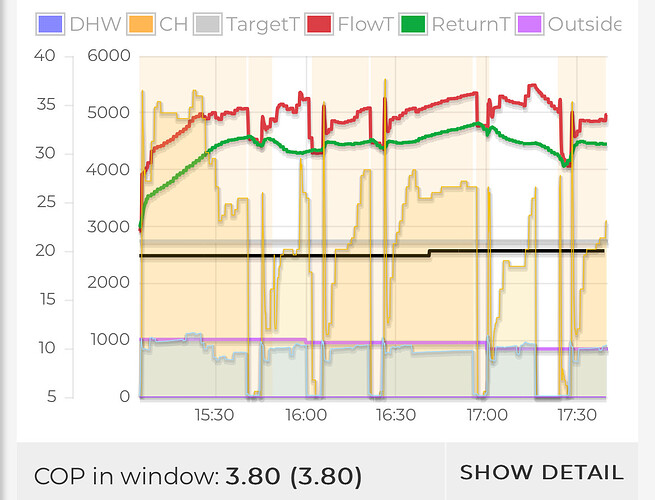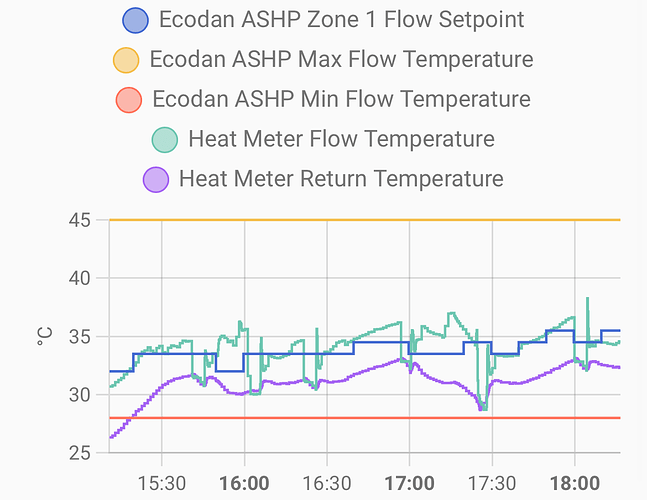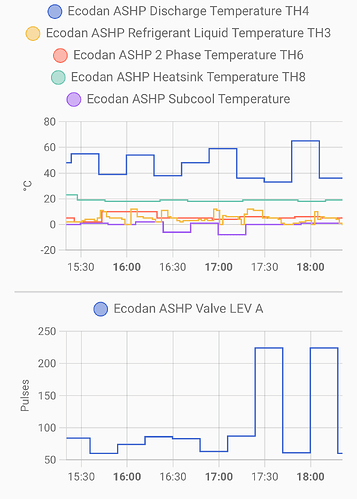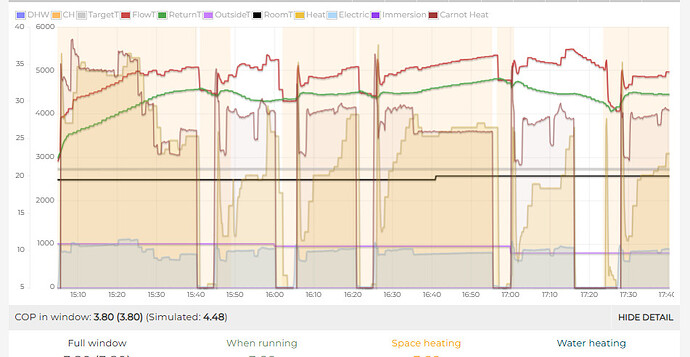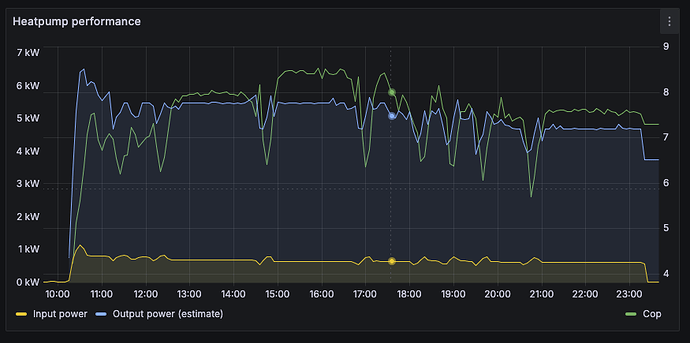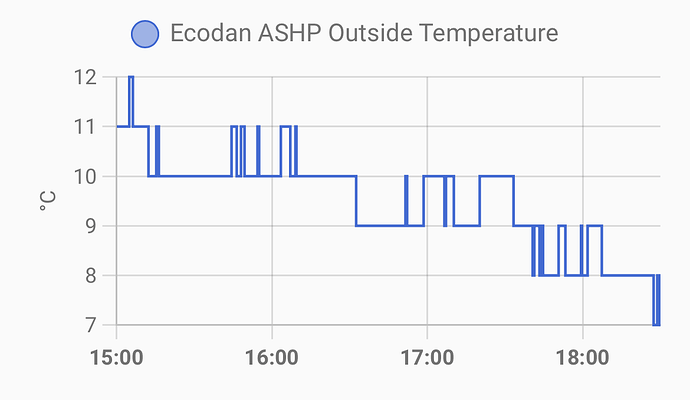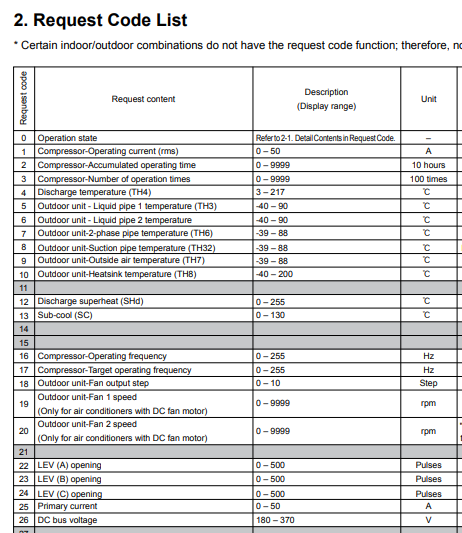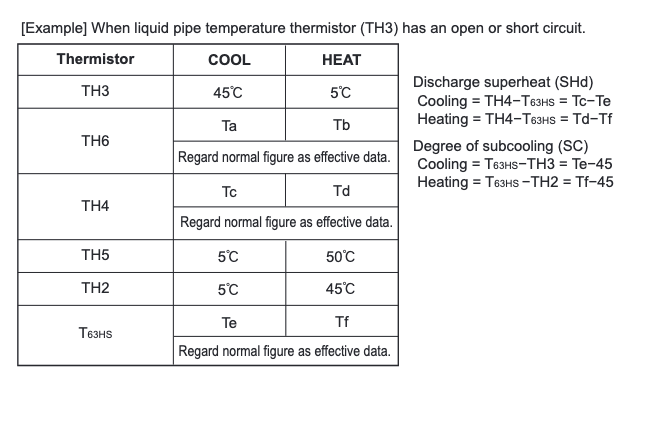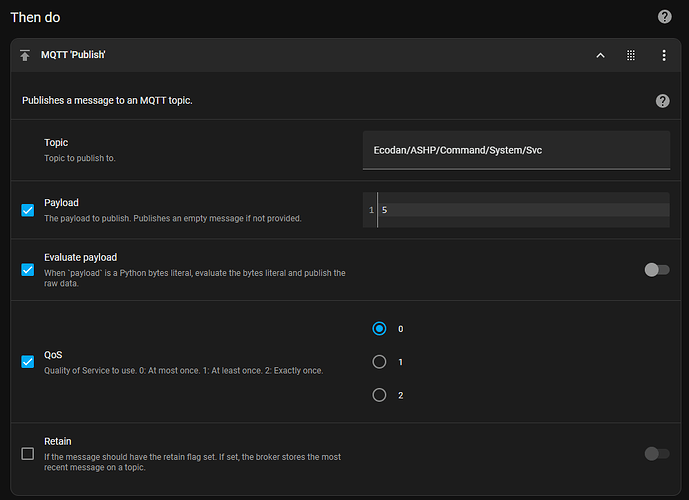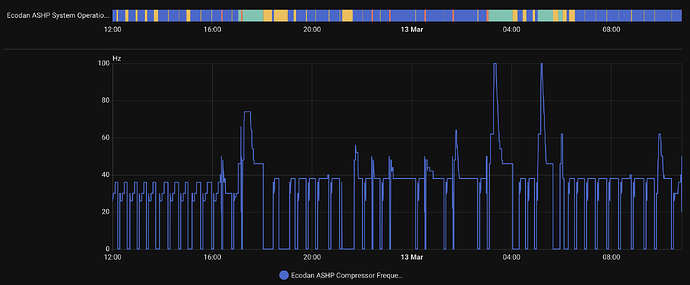I also don’t know if there would be a way to let the user choose what sensors to log and at what frequency from home assistant?
Not sure how this could be done in a way that limits the number of sensors and the frequency to avoid causing issues.
In my firmware I only report TH4, TH3, TH6 and compressor starts en fan speed for units that don’t have ‘free’ outdoor thermistor values.
Can anyone explain this mess…
https://emoncms.org/app/view?name=MyHeatpump&readkey=9b87718992b6ed5756d94d4288059a6f&mode=power&start=1740236690&end=1740246020
I decided to see what would happen if I switched to WC in this mild weather. I was expecting cycling but why is it such a mess. Surely it should just warm up each cycle overshoot because it can’t get rid of the heat pause for a bit and repeat.
This also shows the targeted flow temperature as read from the controller:
Is it just that the target keeps fluctuating and the control of the heat pump overreacts? This value only varies by 0.5K (unless the actual heat pump has a more precise value internally) which is quite a lot for ever changing outdoor temperatures.
It does seem to be doing what we have seen on several occasions. all going quite nicely when it stops at 15:40. it has slowed down, maintaned ae expected efficiency, and stopped. It may not have gone to minimum revs because the discarge superheat is quite low ??.. on re-start at 15:45, it does that odd thing we have observed on a few Ecodans… the COP is terrible, and I suspect the discharge superhaet is very low. it seems to recover (ish) by 16:35. we see then it does not slow down as expected around 18:55, and flow temp rising. I’m guessing the discharge superheat is low again. next patch (around 17:10) is a bit chronic, and at 17:16 its stops, and the circ pump stops too because the flow and return temperatures do not ‘join’ as other ‘off’ periods. No idea what happened at 17:16. I have added the simulated Carnot output. I find that useful
I’ve lost my nerve again and gone back to AA. Tomorrow I might try sticking it on a fixed flow temperature to see what it looks like. If it can manage to more steady then I might vary the set temperature to see if that upsets it in the same way.
@ajdunlop hmm how is your WC setup ? The outside temp seems quite stable, so why would your WC requires a flow temp change? Probably too aggressive?
If I look at the second graph with feed and return I do see that the return is rising and then it cycles. The ecodan do have a somewhat aggressive startup before settling. It seems that it cycles during that initial phase before it can settle. Did you try to lower the feed temp ?
Only the drop at 16:00 is a bit strange, and seems its over reacting on I think 0.5C drop in feed temp. What’s the flow ? It might lower the feed temp since the diff between setpoint and actual is getting too big. I’ve also seen this before, when I lower the setpoint by more that 1c for example.
Today it’s also around 10c here, and heatpump runs quite nice, COP between 7-8.
I’m using the FTC6 Weather Compensation so I don’t control the set temperature except through adjusting the curve.
During that period yesterday the outdoor temperatures recorded by the outdoor unit was:
It only shows with a resolution of 1K and doesn’t seem to have any hysteresis so flicks between values a lot. I don’t know if the FTC does anything to slow down how it reacts to this.
Are you running your own WC curve and using this to set a fixed flow temperature?
yeah that’s a known limitation of the outside thermistor. But it seems your weather was pretty comparable with mines yesterday.
I used to run WC:
30c for outside <= -10
25c for outside >= 10
So the slope is very small and the flow temp will only be adjusted after a couple of degrees change.
But after 2 seasons, I know that I can get away with turning the heating off during the night with these mild temperatures. This season I used the following strategy:
outside temp > 5c, fixed flow of 25c-26c, heating off during the night
outside temp < 5c (like previous week), 24/7 heating. During daytime fixed flow of 27c and at night fixed flow of 26c to reduce the amount of defrost at the cost of some heat loss.
Since my flow rate is always 21-23 L/m, every 1c change equals to:
4.2 * 1 * 21/60 = 1.47kW
4.2 * 1 * 23/60 = 1.61kW
I generally only adjust by 0.5c step because of this. If your flow is in the same ballpark, then adjusting every degree is pretty demanding. It’s the same the other way around (dropping 1c). I try to avoid big changes in demand, and the heatpump seems pretty happy about it
@ajdunlop Can you plot the water pump status for the same period ? Wanted to see if the water pump is kept running during the stops
I should apologise for not engaging well here with all this very interesting stuff. I tend to struggle unless I fully engauge. (Also I was away in Paris last week!).
I have studied the discharge superheat on my 6kW Ecodan, but not the sub cooling (TH34 = liquid temp). When the heat output drops so dramatically, I have assumed its due to liquid refrigerant getting into the suction-line of the compressor… its evaporating using compressor heat rather than evaporating in the plate heatexchanger. The outside heatexchanger will have a lot of liquid in it if it is ‘spilling’ over to the compressor at this time. The plate heatexchanger is likely to be fairly empty given there is only so much refrigerant in the system (The reciever ‘store’ vessel (‘rec’ on schematic) only holds so much refrigerant). IF the plate HE is fairly empty, then TH34 (outlet) will be warmer than the water in. If however the plate HE is full, then no condensing is happening at the bottom. The condensing area is reduced to the top section only, and TH34 will approximately = T water in. I’m curious to know if there is a correlation between the difference between water-in and TH34, and with discharge superheat.
So if I’ve understood correctly it would be useful if the resolution of T32 and T4 were increased @F1p so @johncantor and see what’s going on in the heat exchanger.
Certainly can shuffle some numbers,
Perhaps my service code sheet isn’t current, TH32 isn’t currently read and TH34 isn’t listed?
I think TH34 is the super cool value already read. So would just need to be read more often.
TH34 is the condensed liquid coming out of the plate condenser. To get a subcooling value, I guess the pressure reading (P-sensor) is used, then converted to degrees C. (P-Sensor may be calibrated to give deg C?), then the subcooling is the difference between this and TH34
TH34 is service code 028, its the Brine outlet temp
TH32 is the inlet temp (suction pipe temp, but I think this only available on SHW units)
@johncantor
T63HS is the condensing temp (code 014 if your unit reports it)
@ajdunlop Modified the rates and a few other things for testing
I also don’t know if there would be a way to let the user choose what sensors to log and at what frequency from home assistant?
You can experiment with a Home Assistant automation, writing to topic:
Ecodan/ASHP/Command/Svc with payload Service Code Number
You should not write any faster than about 10s, possibly monitor Telnet logs at the same time - this will be blocking of regular read cycles too
If you are wanting to interrogate a code for a longer period of time i would suggest a rate of 60s, again you may block or reduce regular read speed
Hello all!
I have been looking at this thread for quite some time now and it has helped me improve my COP by quite a lot!
I am hitting a 3.3-3.5 COP on a regular bases, sometimes higher on a warm day.
I have a few questions that would like to ask your wisdom about
I have installed @F1p 's module to monitor the HP better and I have observed a pattern of cycling that looks weird to me.
The HP will turn of for a very short amount of time, about 1 minute every 25-30minutes.
I have checked an my thermostats are calling for heat continuously. I am using a WC curve of 30C at 10 Ambient and 35C at -1 Ambient. My system only has UFH (both upstairs and down stairs). My primary pump is running quite slow to try and meet the needed delta T.
I am wondering, is my target temperature too low and the HP cannot cycle down enough and has to turn off every so often? My units is a 5kW unit and my house is approximately 80m2.
classical cycling. your output capacity falls below the min output of your heatpump.
